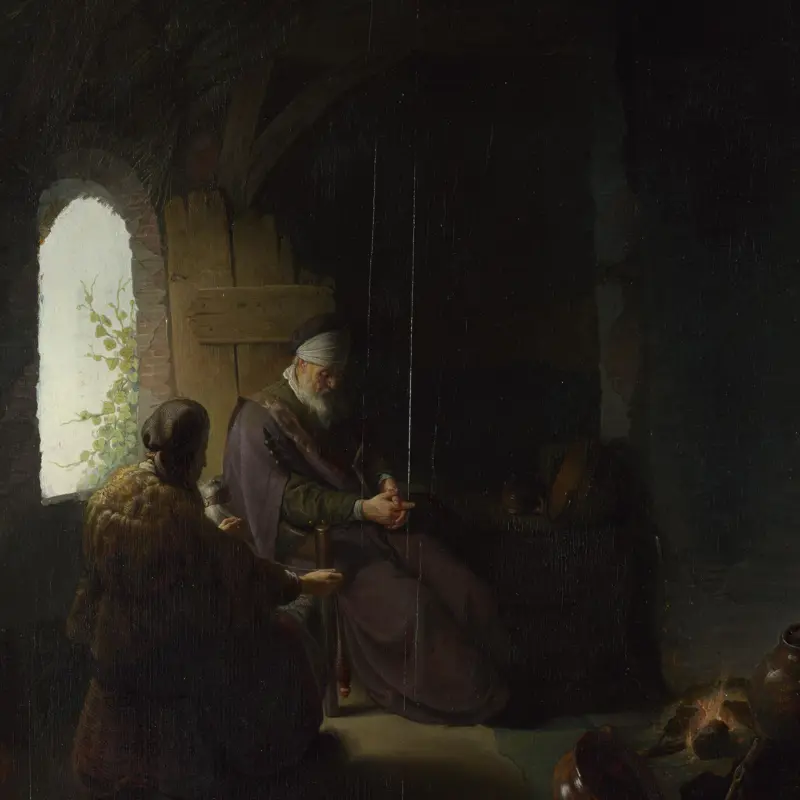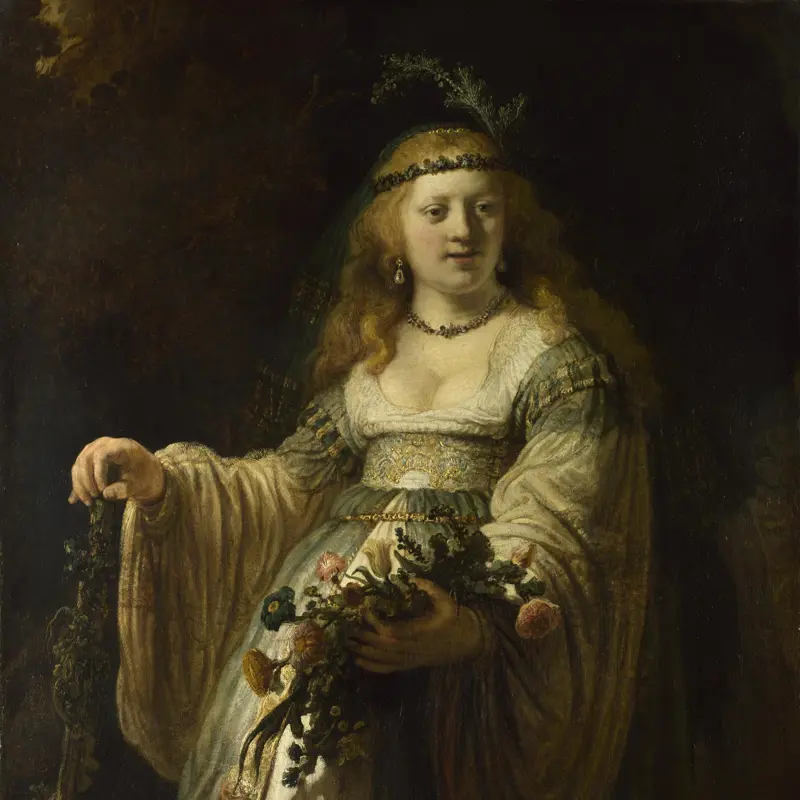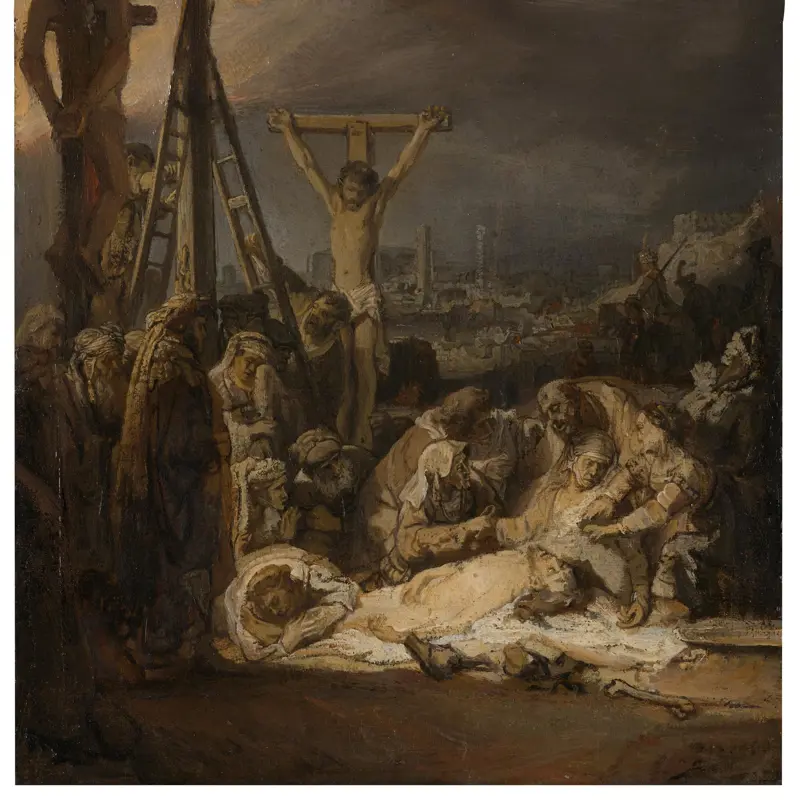Rembrandt, 'Belshazzar's Feast', about 1636-8
About the work
Overview
In his great dramatic painting, Rembrandt tells a story from the Old Testament (Daniel 5: 1–5, 25–8). The man in the gold cloak, enormous turban and tiny crown is Belshazzar, King of Babylon. His father had robbed the Temple of Jerusalem of all its sacred vessels. Using these to serve food at a feast, as Belshazzar does here, was seen as sacrilege.
In the middle of the party, a clap of thunder came as a warning. God’s hand appeared from a cloud and wrote in Hebrew script: ‘You have been weighed in the balance and found wanting.’ Within hours, Belshazzar was dead.
In Amsterdam, churches were plain, but people had pictures, some of them religious, in their homes. Encouraged to read the Bible, they would have been familiar with Belshazzar’s fate and with the cautionary message of the story of a wicked king watched by heavenly eyes – like the piercing eyes of the recorder player looking out from the shadows.
Key facts
Details
- Full title
- Belshazzar's Feast
- Artist
- Rembrandt
- Artist dates
- 1606 - 1669
- Date made
- About 1636-8
- Medium and support
- Oil on canvas
- Dimensions
- 167.6 × 209.2 cm
- Inscription summary
- Signed; Dated
- Acquisition credit
- Bought with a contribution from the Art Fund, 1964
- Inventory number
- NG6350
- Location
- Room 22
- Collection
- Main Collection
- Frame
- 21st-century Replica Frame
Provenance
Additional information
Text extracted from the ‘Provenance’ section of the catalogue entry in Neil MacLaren, revised and expanded by Christopher Brown, ‘National Gallery Catalogues: The Dutch School: 1600–1900’, London 1991; for further information, see the full catalogue entry.
Exhibition history
-
2008Rembrandt. History PainterMuseo Nacional del Prado15 October 2008 - 6 January 2009
-
2014Loan to Museumslandschaft Hessen KasselMuseumslandschaft Hessen Kassel15 October 2014 - 31 May 2015
-
2017Rubens and RembrandtThe National Gallery (London)22 March 2017 - 6 August 2017
-
2018Rembrandt: Britain's Discovery of the MasterScottish National Gallery7 July 2018 - 14 October 2018
-
2021The Director's Choice: Lizards, Fancy Feathered Hats and TrickeryThe National Gallery (London)5 May 2021 - 9999
Bibliography
-
1829
J. Smith, A Catalogue Raisonné of the Works of the Most Eminent Dutch, Flemish, and French Painters: In Which is Included a Short Biographical Notice of the Artists, with a Copious Description of Their Principal Pictures […], 9 vols, London 1829-1842
-
1852British Institution, Catalogue of Pictures by Italian, Spanish, Flemish, Dutch, French and English Masters, with which the Proprietors have Favoured the Institution, London 1852
-
1875G. Scharf, A Descriptive and Historical Catalogue of the Collection of Pictures at Knowsley Hall, London 1875
-
1897W. von Bode and C. Hofstede de Groot, The Complete Work of Rembrandt, 8 vols, Paris 1897
-
1907C. Hofstede de Groot, Catalogue Raisonné of the Works of the Most Eminent Dutch Painters of the Seventeenth Century, 10 vols, London 1907
-
1907C. Hofstede de Groot, Catalogue Raisonné of the Works of the Most Eminent Dutch Painters of the Seventeenth Century, 10 vols, London 1907
-
1953J.G. van Gelder, 'Rembrandt and His Circle', The Burlington Magazine, XCV/599, 1953, pp. 34-9
-
1956W. Sumowski, 'Eine Anmerkung zu Rembrandts Gastmal des Belsazar', Oud Holland, LXXI, 1956
-
1963R. Hausherr, 'Zur Menetekel-Inschrift auf Rembrandts Belsazarbild', Oud Holland, LXXVIII, 1963, pp. 142-9
-
1965The National Gallery, The National Gallery: June 1962 - December 1964, London 1965
-
1966K. Clark, Rembrandt and the Italian Renaissance, London 1966
-
1969C. Tümpel, 'Studien zur Ikonographie der Historien Rembrandts: Deutung und Interpretation der Bildinhalte', Nederlands Kunsthistorisch Jaarboek, 1969, pp. 107-98
-
1977H. Kauffmann, 'Rembrandts Belsazar', in Festschrift Wolfgang Braunfels, Tübigen 1977, pp. 167-76
-
1980D. Lettieri, 'Text, Narrative and Tradition: Scenes from Esther by Aert de Gelder', J. Paul Getty Museum Journal, VIII, 1980, pp. 69-86
-
1980A. Blankert et al., Gods, Saints and Heroes, Dutch Painting in the Age of Rembrandt (exh. cat. National Gallery of Art, Washington, 2 November 1980 - 4 January 1981; Detroit Institute of Arts, 16 February - 19 April 1981; Rijksmuseum, 18 May - 19 July 1981), Washington 1980
-
1985G. Schwartz, Rembrandt: His Life, His Paintings, Harmondsworth 1985
-
1988D. Bomford et al., Rembrandt (exh. cat. The National Gallery, 12 October 1988 - 17 January 1989), London 1988
-
1989J. Mills and R. White, 'Paint Media Analyses', National Gallery Technical Bulletin, XIII, 1989, pp. 69-71
-
1991Maclaren, Neil, revised by Christopher Brown, National Gallery Catalogues: The Dutch School, 1600-1900, 2nd edn (revised and expanded), 2 vols, London 1991
-
1991C. Brown, J. Kelch and P.J.J. van Thiel, Rembrandt: The Master and his Workshop (exh. cat. Gemäldegalerie SMPK at the Altes Museum, 12 September - 10 November 1991; Rijksmuseum, 4 December - 1 March 1992; The National Gallery, London, 25 March - 24 May 1992), New Haven 1991
-
1993C. Tümpel, Rembrandt: All Paintings in Colour, Antwerp 1993
-
1993R.J. Littman, 'An Error in the Menetekel Inscription in Rembrandt's Belshazzar's Feast in the National Gallery in London', Oud Holland, CVII, 1993, pp. 296-7
-
1994S. Perlove, 'Awaiting the Messiah: Christians, Jews, and Muslims in the Late Work of Rembrandt', Bulletin of the University of Michigan Museums of Art and Archaeology, XI, 1994, pp. 85-113
-
1994R. White and J. Kirby, 'Rembrandt and his Circle: Seventeenth-Century Dutch Paint Media Re-Examined', National Gallery Technical Bulletin, XV, 1994, pp. 64-78
-
1995R.-M. Hagen and R. Hagen, 'Das Unheil steht schon an die Wand geschrieben', Art, V, 1995, pp. 88-93
-
1996J. Stückelberger, Rembrandt und die Moderne. Der Dialog mit Rembrandt in der deutschen Kunst um 1900, Munich 1996
-
1996A. Prater, 'Rembrandts Stilleben', Pantheon, 1996, pp. 62-76
-
1996H.P. Chapman, W.T. Kloek and A.K. Wheelock, Jan Steen: Painter and Storyteller (exh. cat. National Gallery of Art, Washington, 28 April - 18 August 1996; Rijksmuseum, 21 September 1996 - 12 January 1997), Washington 1996
-
1997J.I. Israel, 'Adjusting to Hard Times: Dutch Art During Its Period of Crisis and Restructuring (c. 1621 - c. 1645)', Art History, XX/3, 1997, pp. 449-76
-
2001
C. Baker and T. Henry, The National Gallery: Complete Illustrated Catalogue, London 2001
Frame
This reproduction frame was made in 2009 in the style of a seventeenth-century Dutch frame. An ebonised box frame, the back moulding begins with an edge roll leading to a flat section, followed by grooves and two steps that lead to the wide frieze. This is followed by a second edge that transitions into a gilded sight edge, concluding with a cavetto and step.
This frame, crafted by Erik Dop, was inspired by the one surrounding Frans Hals’s Regents of the St Elizabeth Hospital of Haarlem (Frans Hals Museum, Haarlem).
About this record
If you know more about this work or have spotted an error, please contact us. Please note that exhibition histories are listed from 2009 onwards. Bibliographies may not be complete; more comprehensive information is available in the National Gallery Library.



























